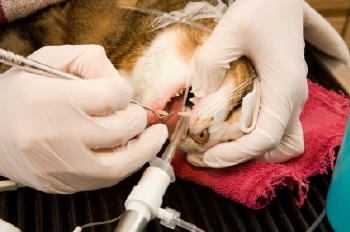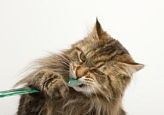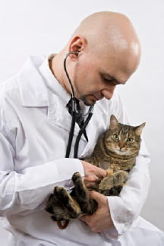Cat Teeth Diseases

Signs of Cat Teeth Diseases
- Pale or blue gums or tongue
- Excessive drooling
- Growths
- Ulcers
- Misaligned teeth
- Trouble swallowing or eating
- Swelling
- Halitosis
- Open-mouth breathing
If your cat's gums and the mucous membranes around it's eyes are pale, it may be bleeding internally or suffering from anemia or a number of other systemic diseases. Call your vet immediately.
Some problems are genetic, inherited tendencies (both of my Himalayans had genetic gum problems), strength of the immune system, and the structure of the mouth help determine how much plaque and tartar develop.
The Importance of Diet
We've discussed the importance of cleaning cat teeth but another important preventative to cat teeth diseases is proper food choices. Feeding crunchy foods other than moist or semi-moist foods is better for the teeth but those moister foods should also be scheduled into the diet for other nutritional benefits that contribute to good health for other body organs.
While dry food can help to prevent tartar, it is not the only answer. Researchers are working to improve moister foods so they don't stick to the tooth as readily, hence allowing food particles to remain in the mouth and bacteria to grow. Plaque mineralizes and forms hard deposits called tartar...just like in humans, and the beginning of cat teeth diseases.
Gingivitis
Healthy gums will be firm to the touch, closely attached to the teeth, and pink in un-pigmented areas. Many cats will have black spots on their gums, sometimes in large numbers...these are normal. What is not normal are inflamed, reddened gums, known as gingivitis.
- In minor cases, gingivitis often goes undetected because the problem is well-tolerated by most cats. Only the most observant owners will see its presence. However, severe gingivitis is another matter. Symptoms are drooling, bad breath, and pain or problems eating. If you examine your cat's mouth, you will see red, swollen, ulcerated and bleeding gums. The gums may be painful or bleed when touched. Annual checkups at the vet will catch this pending disaster before it gets this serious but oftentimes limited funds put your cat's vet visits on a lower priority. Cat teeth diseases will just get more expensive to deal with, so earlier is wise.
Causes of gingivitis include: Dental disease, such as plaque and tartar buildup, cavities, and broken teeth (which can lead to bone infections).
Viruses, such as feline calicivirus (primarily associated with upper respiratory disease) and feline leukemia virus (FeLV). - Systemic diseases, such as kidney disease and diabetes mellitus.
- Squamous cell carcinoma (a malignant tumor).
- Pemphigus, an immune disorder affecting the skin and mucous membranes.
- Eosinophilic granuloma complex (EGC)
- Lymphocytic or plasmacytic gingivitis-pharyngitis-stomatitis
- In the case of plaque and tartar buildup gingivitis is caused by enzymes that are released by the bacteria and then attack the surrounding tissue. The gums get red and swollen, and the tissue becomes tender and may bleed easily.
- Unfortunately, when the cat's immune system tries to fight the bacteria, the condition gets worse. The gums begin to recede from the teeth, and bone destruction could progress to tooth loss.
Gingivitis is reversible and can be treated with thorough plaque removal. Antibiotics or tooth extraction may be required in some cases.
Periodontal Disease is more serious than Gingivitis
Symptoms of periodontal disease, one of the worst cat teeth diseases include brown debris on teeth, red swollen gums that easily bleed, loose teeth, receding gums, and a cat who is reluctant to eat. A cervical cavity or neck lesion is another form of this disease. Researchers have a number of theories as to what causes this unique tooth decay. They range from diet to immune disorder to virus and to the environment.
What happens is decay forms between the root and crown at the neck of the tooth, where the gum line begins. The cavities eat away at the inside of the tooth and leave it hollow. They are hard to find because they're often hidden beneath swollen gum tissue. X-rays are usually needed for detection.
Periodontal disease is irreversible and may require advanced therapy to prevent progression of the disease. Chewing pumps infection into the cat's bloodstream, an infection can quickly turn into much more. The potential exists for damage in the lungs, heart, liver, and kidneys. The damage can either cause sudden disease or a slow, worsening deterioration that shortens the life of your cat.
Just 10 minutes of cat health care (cleaning it's teeth weekly and feeding a crunchy diet (only supplemented with wet food) can make a big difference in fending off cat teeth diseases.
Related Articles......
Return from Cat Teeth Diseases to Cat Health Homepage
Having trouble finding what you need? Cat Health Index & Site Map
OR
Do you have a question to ask?...Questions
OR
Do you have a cat story to share?...Simply click here to go to that page!
Copyright@2010-2020 All rights reserved.Cat-health-detective.com
This website is information only. Consult a veterinarian for medical assistance

"Like Us" on Facebook
or...
"Like Us" here




















